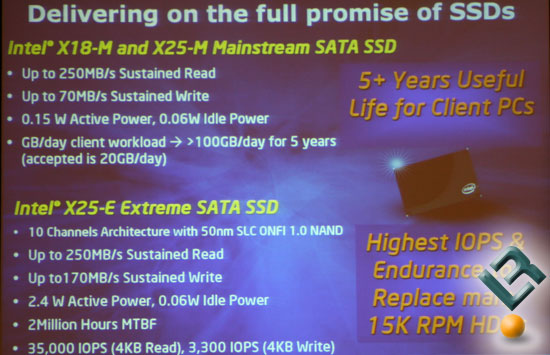IDF 2008 – Intel Solid State Drives and Inside The X18-M
Intel Announces SSD Drives
One of the most anticipated SATA Solid State Drives (SSD) to come to market has been the upcoming series by Intel. During a briefing at IDF yesterday we found out some more details on these drives and actually have an non-working engineering sample to take home with us. Intel will be two different SSD models with one being for the mainstream market and the other is an extreme model that is aimed at those wanting the most performance possible.

The Intel Mainstream SATA Solid State Drives come in both 1.8 and 2.5in form factors (X18-M and X25-M. They are based on Multi-Level Cell NAND Flash Memory using the same ten parallel channel architecture. As a result of this, Intel is able to increase the storage capacities up to 80GB and 160GB, which is ideal for the mainstream market that desires storage space. The Intel X25-M Mainstream SATA SDD has a sustained read and write speeds of up to 250MB/sec and 70MB/sec respectively.
The flagship model, the Intel X25-E Extreme SATA Solid State Drive, will come in smaller 32GB and 64GB capacities and is only available in a 2.5in form factor. This drive is clearly aimed at servers and high-performance computing markets that are looking for fast write speeds. What makes this drive different from an internal perspective is the fact that it is based on Single-Level Cell NAND Flash Memory technology (still uses ten parallel channel architecture found on the mainstream drives). The Intel X25-E Extreme SATA SDD has a sustained read and write speeds of up to 250MB/sec and 170MB/sec respectively.

When it comes to performance Bradd Berdelman from Falcon Northwest brought a cpuple Fragboxes to do a gaming demo showing how the Intel SATA SSD’s will improve gaming perfomance in the game Crysis. He flipped the numbers on his PowerPoint presentation, but a single SATA SSD had 32.65 frames per second (FPS) versus the 16.76 FPS found on an identical system with a pair of Western Digital VelociRaptor hard drives in RAID0. Bradd said that during the benchmark that the game needs to pull data off the disk drive and the WD VelociRaptor setup in RAID 0 had a latency of 7-8ms verus a latency of just 0.1ms on the Intel SATA SSD. Over the course of the benchmark the hundreds or thousands of disk reads slow down gaming performance enough to make a difference in the performance numbers.

If you are curious how the Intel SATA Solid State Drives stack up against competitive SSDs you have nothing to worry about. Intel was very certain that they have the performance lead and will destroy any SSD currently on the market. The only thing Intel wasn’t talking about when it came to their SSD was pricing, which is just slightly important! Let’s take a look at the Intel X18-M and take it apart!

Comments are closed.